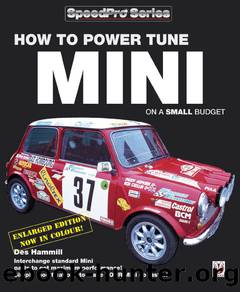How to Power Tune Mini on a Small Budget by Des Hammill

Author:Des Hammill
Language: eng
Format: epub
ISBN: 9781845845872
Publisher: Veloce Publishing Ltd
Published: 2013-12-10T00:00:00+00:00
Chapter 6
Fuel & octane ratings
The vast majority of fuels commercially available around the developed world these days are unleaded, and the octane rating of these fuels ranges from 90 to 98.3 RON (as of 2005). The last of the tetraethyl-leaded fuels were, on average, 93-98 RON octane, but they have now gone from all developed countries of the world, even for motor racing purposes. There are two basic tests used worldwide to determine the octane ratings of petrol/gasoline used in cars. These two test methods are the Research Octane Number (RON) and the Motor Octane Number (MON).
In the late 1920s, the Co-operative Fuels Research Council (CFR) in the USA devised a fuel sample testing method for determining the octane ratings of petrol/gasoline mixes. A very special single cylinder engine was made which had variable compression ratio and ignition timing (commonly referred to as a CFR engine). This very same engine is still used to test fuel samples for RON and MON using two different testing regimes or methods. Before a fuel sample is tested, the CFR engine is calibrated using a pure chemical mix âreference fuelâ, which, because of its specific chemical content, is guaranteed to be 100 octane.
A sample of fuel to be tested is then used to run the engine. The RON method of obtaining an octane rating sees the CFR engine run at 600rpm with a set amount of ignition timing, as prescribed by ASTM D2699/IP237 (13 degrees Before Top Dead Centre). This rating is regarded as being representative of how the particular fuel will cause an engine to go at start up and idle. ASTM stands for American Society for Testing and Materials, and D2699 is the criteria of its RON test. IP stands for Institute of Petroleum, and 237 is its number for this testing regime (same test).
The same sample of fuel is again used to run the engine and the MON method of obtaining an octane rating is conducted under ASTM D2700/IP236 criteria. The CFR engine is run at 900rpm, the compression ratio is increased, and the ignition timing is advanced. The octane derived from this test is regarded as being representative of how the particular fuel sample will cause an engine to go on the road at cruise conditions or motorway driving. You virtually never see a MON rating displayed on a pump in a service station, but the two ratings are used by all petrol companies around the world. BS4040, for example, lists a minimum requirement for both RON and MON, but you only ever see the RON rating displayed on a pump.
At the time of writing (2005), the UK still has some leaded fuel available to motorists/enthusiasts. When tetraethyl-lead fuel was phased out in 2000, the British Government allowed 1% of the total amount of petrol made and sold in the UK to be leaded. The petrol companies which decided to make this fuel and appoint selected outlets to sell it, used 0.099 grams per litre of tetraethyl-lead which provides acceptable valve seat protection and the fuel is 98 RON/86.
Download
This site does not store any files on its server. We only index and link to content provided by other sites. Please contact the content providers to delete copyright contents if any and email us, we'll remove relevant links or contents immediately.
| Buyers' Guides | Classic Cars |
| Customize | Driver's Education |
| Electric & Hybrid | Foreign |
| History | Industry |
| Insurance | Luxury |
| Motorcycles | Pictorial |
| Racing | Repair & Maintenance |
| Trucks & Vans |
Machine Learning at Scale with H2O by Gregory Keys | David Whiting(4260)
Never by Ken Follett(3884)
Urban Outlaw by Magnus Walker(3366)
OPNsense Beginner to Professional by Julio Cesar Bueno de Camargo(3262)
Sapiens and Homo Deus by Yuval Noah Harari(3031)
Will by Will Smith(2873)
A Short History of Nearly Everything by Bryson Bill(2662)
Hooked: A Dark, Contemporary Romance (Never After Series) by Emily McIntire(2527)
Rationality by Steven Pinker(2327)
Borders by unknow(2281)
The Becoming by Nora Roberts(2153)
Holy Bible (NIV) by Zondervan(2101)
HBR's 10 Must Reads 2022 by Harvard Business Review(1821)
A Short History of War by Jeremy Black(1817)
The One Percenter Encyclopedia by Bill Hayes(1811)
Freedom by Sonny Barger(1785)
Go Tell the Bees That I Am Gone by Diana Gabaldon(1732)
Five Ways to Fall by K.A. Tucker(1726)
Girls Auto Clinic Glove Box Guide by Patrice Banks(1708)
